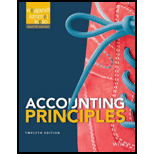
Concept explainers
(a)
Bad debts can be defined as those
Bad debts are considered as expenses, as they are not anticipated to generate any financial benefits in the future. It leads to a corresponding decrease in the balance of accounts receivable on the
Procedure for debiting and crediting an account:
- Increase in assets account, increase in expenses account, and decrease in liabilities account should be debited.
- Decrease in assets account, increase in revenue account, and increase in liabilities account should be credited.
All transactions affect the
To determine: The total estimated bad debts.
(b)
To prepare:
(c)
To prepare: The
(d)
To prepare: The journal entries to record the restore the account and record the cash collection.
(e)
To ascertain: The bad debts estimates if R Inc. had used 4% percent of accounts receivable and the advantage of using aging the accounts receivable over a percentage to total accounts receivable.
Want to see the full answer?
Check out a sample textbook solution
Chapter 9 Solutions
Accounting Principles - Standalone book

 AccountingAccountingISBN:9781337272094Author:WARREN, Carl S., Reeve, James M., Duchac, Jonathan E.Publisher:Cengage Learning,
AccountingAccountingISBN:9781337272094Author:WARREN, Carl S., Reeve, James M., Duchac, Jonathan E.Publisher:Cengage Learning, Accounting Information SystemsAccountingISBN:9781337619202Author:Hall, James A.Publisher:Cengage Learning,
Accounting Information SystemsAccountingISBN:9781337619202Author:Hall, James A.Publisher:Cengage Learning, Horngren's Cost Accounting: A Managerial Emphasis...AccountingISBN:9780134475585Author:Srikant M. Datar, Madhav V. RajanPublisher:PEARSON
Horngren's Cost Accounting: A Managerial Emphasis...AccountingISBN:9780134475585Author:Srikant M. Datar, Madhav V. RajanPublisher:PEARSON Intermediate AccountingAccountingISBN:9781259722660Author:J. David Spiceland, Mark W. Nelson, Wayne M ThomasPublisher:McGraw-Hill Education
Intermediate AccountingAccountingISBN:9781259722660Author:J. David Spiceland, Mark W. Nelson, Wayne M ThomasPublisher:McGraw-Hill Education Financial and Managerial AccountingAccountingISBN:9781259726705Author:John J Wild, Ken W. Shaw, Barbara Chiappetta Fundamental Accounting PrinciplesPublisher:McGraw-Hill Education
Financial and Managerial AccountingAccountingISBN:9781259726705Author:John J Wild, Ken W. Shaw, Barbara Chiappetta Fundamental Accounting PrinciplesPublisher:McGraw-Hill Education





